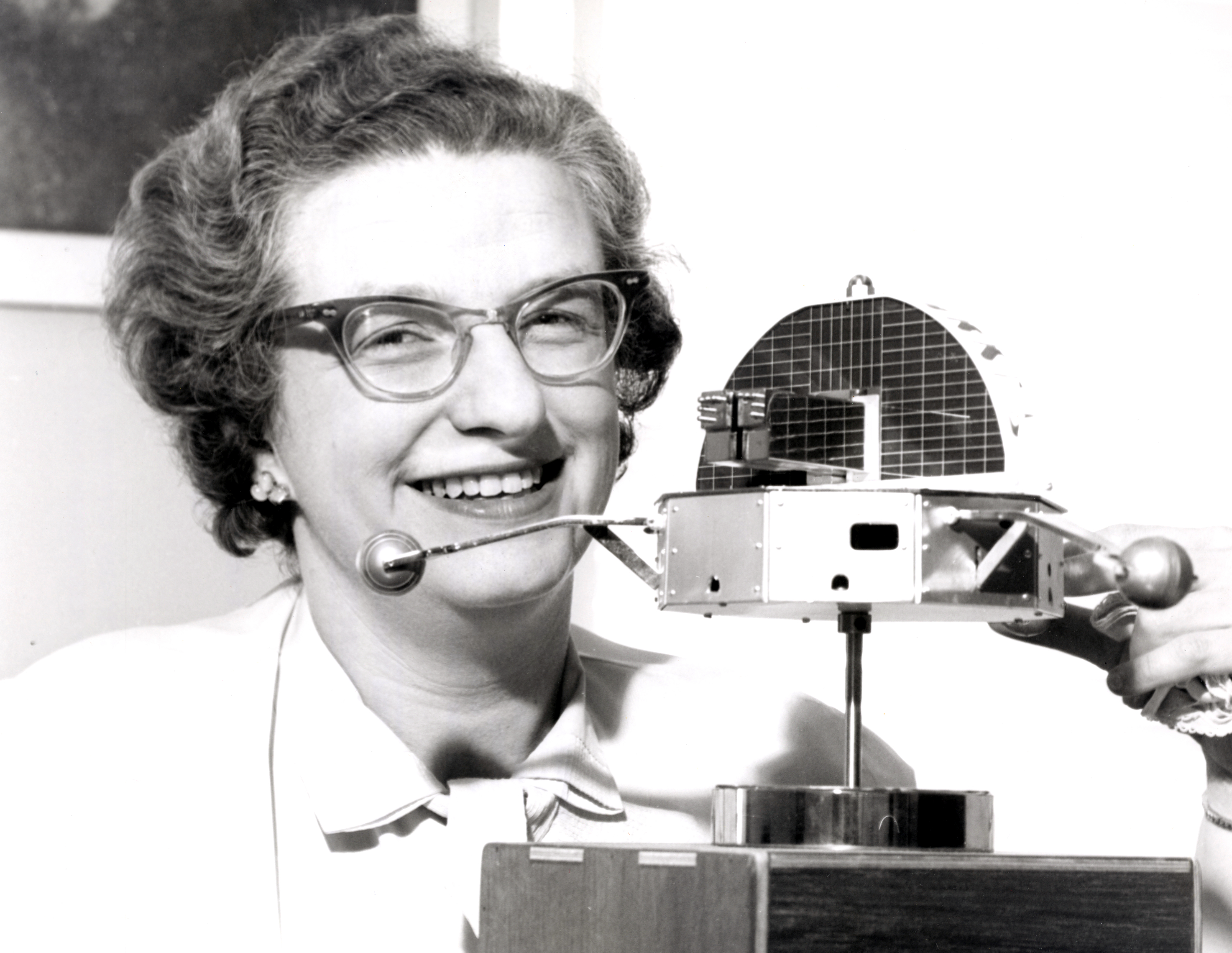|
Orbiting Solar Observatory
The Orbiting Solar Observatory (abbreviated OSO) Program was the name of a series of American space telescopes primarily intended to study the Sun, though they also included important non-solar experiments. Eight were launched successfully into low Earth orbit by NASA between 1962 and 1975 using Delta rockets. Their primary mission was to observe an 11-year sun spot cycle in UV and X-ray spectra. The initial seven (OSO 1–7) were built by Ball Aerospace, then known as Ball Brothers Research Corporation (BBRC), in Boulder, Colorado.Todd Neff (2010From Jars to the Stars: How Ball Came to Build a Comet-Hunting Machine Denver, CO.: Earthview Media. OSO 8 was built by Hughes Space and Communications Company, in Culver City, California. History Nancy Roman oversaw the development of the Orbiting Solar Observatory program from 1961 to 1963. The basic design of the entire series featured a rotating section, the "Wheel", to provide gyroscopic stability. A second section, the "S ... [...More Info...] [...Related Items...] OR: [Wikipedia] [Google] [Baidu] |
Oso Diagram
Oso, or OSO, may refer to: Places * Oso, Ontario, a community and former township now part of Central Frontenac Township, Ontario, Canada *Oso, Washington, a census-designated place in Snohomish County, Washington Music *Oṣó, sixth studio album by Brymo * Oso Oso, an emo band Other *Oakville Symphony Orchestra * Offensive Systems Officer, military aircrew member * Ose (demon) or Oso *Onsala Space Observatory *Orbiting Solar Observatory The Orbiting Solar Observatory (abbreviated OSO) Program was the name of a series of American space telescopes primarily intended to study the Sun, though they also included important non-solar experiments. Eight were launched successfully into ..., series of nine satellites **OSO 3 **OSO 7 *Ottawa Symphony Orchestra *''Om Shanti Om'', Hindi film starring Shahrukh Khan, Deepika Padukone and Arjun Rampal * Special Council of the NKVD; Russian "ОСО," transliterated "OSO" *Special Agent Oso, a Disney Channel animated show for children *Osbo ... [...More Info...] [...Related Items...] OR: [Wikipedia] [Google] [Baidu] |
OSO 3
OSO 3 (Orbiting Solar Observatory 3), or Third Orbiting Solar Observatory (known as OSO E2 before launch) was launched on March 8, 1967, into a nearly circular orbit of mean altitude 550 km, inclined at 33° to the equatorial plane. Its on-board tape recorder failed on June 28, 1968, allowing only the acquisition of sparse real-time data during station passes thereafter; the last data were received on November 10, 1969. OSO 3 reentered the Earth's atmosphere and burned up on April 4, 1982. Like all the American Orbiting Solar Observatory (OSO) series satellites, it had two major segments: one, the "Sail", was stabilized to face the Sun, and carried both solar panels and Sun-pointing experiments for solar physics. The other, "Wheel" section, rotated to provide overall gyroscopic stability and also carried sky scanning instruments that swept the sky as the wheel turned, approximately every 2 seconds. Instrumentation The Sail carried a hard X-ray experiment from UCSD, ... [...More Info...] [...Related Items...] OR: [Wikipedia] [Google] [Baidu] |
Solwind
P78-1 or Solwind was a United States satellite launched aboard an Atlas F rocket from Vandenberg Air Force Base in California on February 24, 1979. The satellite's mission was extended by several weeks, so that it operated until it was destroyed in orbit on September 13, 1985, to test the ASM-135 ASAT anti-satellite missile. Construction and payload The satellite's Orbiting Solar Observatory (OSO) platform included a solar-oriented sail and a rotating wheel section. Ball Aerospace was the primary contractor for design and construction, and provided the attitude control and determination computer programs. The P78-1 carried a gamma-ray spectrometer, a white-light coronagraph, an extreme-ultraviolet imager, an X-ray spectrometer, a high-latitude particle spectrometer, an aerosol monitor, and an X-ray monitor. The X-ray monitor, designated NRL-608 or XMON, was a collaboration between the Naval Research Laboratory and Los Alamos National Laboratory. The white-light coronagraph a ... [...More Info...] [...Related Items...] OR: [Wikipedia] [Google] [Baidu] |
Advanced Orbiting Solar Observatory, Udvar-Hazy Center
The Advanced Party (), otherwise known as the Advanced Association () was a liberal and centrist Zionist political association in Mandatory Palestine founded by several urban liberal Zionists. The party was founded in order to represent the voice of Tel Aviv liberals and Zionists in the election to the Yishuv's Assembly of Representatives in 1920. The party placed sixth in the election, coming in behind their rural General Zionist counterrpart, Hitahdut HaIkarim. The party represents first formal General Zionist political party to be founded, and as one of the earliest political ancestors of the modern-day Likud. History Under the British Mandate, the Yishuv (Jewish community), established a network of political and administrative institutions, among them the Assembly of Representatives.Itamar Rabinovich & Jehuda Reinharz (2008''Israel in the Middle East''Brandeis University Press, p84 To ensure that small groups were properly represented, a system of proportional representation ... [...More Info...] [...Related Items...] OR: [Wikipedia] [Google] [Baidu] |
Galaxy Cluster
A galaxy cluster, or a cluster of galaxies, is a structure that consists of anywhere from hundreds to thousands of galaxies that are bound together by gravity, with typical masses ranging from 1014 to 1015 solar masses. Clusters consist of galaxies, heated gas, and dark matter. They are the second-largest known gravitationally bound structures in the universe after superclusters. They were believed to be the largest known structures in the universe until the 1980s, when superclusters were discovered. Small aggregates of galaxies are referred to as galaxy groups rather than clusters of galaxies. Together, galaxy groups and clusters form superclusters. Basic properties Galaxy clusters typically have the following properties: * They contain 100 to 1,000 galaxies, hot X-ray emitting gas and large amounts of dark matter. Details are described in the "Composition" section. * They have total masses of 1014 to 1015 solar masses. * They typically have diameters from 1 to 5 Mpc ( ... [...More Info...] [...Related Items...] OR: [Wikipedia] [Google] [Baidu] |
Spectrum
A spectrum (: spectra or spectrums) is a set of related ideas, objects, or properties whose features overlap such that they blend to form a continuum. The word ''spectrum'' was first used scientifically in optics to describe the rainbow of colors in visible light after passing through a prism. In the optical spectrum, light wavelength is viewed as continuous, and spectral colors are seen to blend into one another smoothly when organized in order of their corresponding wavelengths. As scientific understanding of light advanced, the term came to apply to the entire electromagnetic spectrum, including radiation not visible to the human eye. ''Spectrum'' has since been applied by analogy to topics outside optics. Thus, one might talk about the " spectrum of political opinion", or the "spectrum of activity" of a drug, or the " autism spectrum". In these uses, values within a spectrum may not be associated with precisely quantifiable numbers or definitions. Such uses imply a bro ... [...More Info...] [...Related Items...] OR: [Wikipedia] [Google] [Baidu] |
Emission Spectrum
The emission spectrum of a chemical element or chemical compound is the Spectrum (physical sciences), spectrum of frequencies of electromagnetic radiation emitted due to electrons making a atomic electron transition, transition from a high energy state to a lower energy state. The photon energy of the emitted photons is equal to the energy difference between the two states. There are many possible electron transitions for each atom, and each transition has a specific energy difference. This collection of different transitions, leading to different radiated wavelengths, make up an emission spectrum. Each element's emission spectrum is unique. Therefore, spectroscopy can be used to identify elements in matter of unknown composition. Similarly, the emission spectra of molecules can be used in chemical analysis of substances. Emission In physics, emission is the process by which a higher energy quantum mechanical state of a particle becomes converted to a lower one through the emis ... [...More Info...] [...Related Items...] OR: [Wikipedia] [Google] [Baidu] |
High-mass X-ray Binary
X-ray binaries are a class of binary stars that are luminous in X-rays. The X-rays are produced by matter falling from one component, called the ''donor'' (usually a relatively common main sequence star), to the other component, called the ''accretor'', which can be a white dwarf, neutron star or black hole. The infalling matter releases gravitational potential energy, up to 30 percent of its rest mass, as X-rays. (Hydrogen fusion releases only about 0.7 percent of rest mass.) The lifetime and the mass-transfer rate in an X-ray binary depends on the evolutionary status of the donor star, the mass ratio between the stellar components, and their orbital separation. An estimated 1041 positrons escape per second from a typical low-mass X-ray binary. Classification X-ray binaries are further subdivided into several (sometimes overlapping) subclasses, that perhaps reflect the underlying physics better. Note that the classification by mass (high, intermediate, low) refers to the ... [...More Info...] [...Related Items...] OR: [Wikipedia] [Google] [Baidu] |
Vela X-1
Vela X-1 is a pulsing, eclipsing high-mass X-ray binary (HMXB) system, associated with the Uhuru source 4U 0900-40 and the supergiant star HD 77581. The X-ray emission of the neutron star is caused by the capture and accretion of matter from the stellar wind of the supergiant companion. Vela X-1 is the prototypical detached HMXB. The orbital period of the system is 8.964 days, with the neutron star being eclipsed for about two days of each orbit by HD 77581. It has been given the variable star designation GP Velorum, and it varies from visual magnitude 6.76 to 6.99. The spin period of the neutron star is about 283 seconds, and gives rise to strong X-ray pulsations. The mass of the pulsar is estimated to be at least solar masses. Characteristics Long term monitoring of the spin period shows small random increases and decreases over time similar to a random walk. The accreting matter causes the random spin period changes. However, a recent study has detected ... [...More Info...] [...Related Items...] OR: [Wikipedia] [Google] [Baidu] |
OSO 7
OSO 7 or Orbiting Solar Observatory 7 (NSSDC ID: 1971-083A), before launch known as OSO H is the seventh in the series of American Orbiting Solar Observatory satellites launched by NASA between 1962 and 1975. OSO 7 was launched from Cape Kennedy (now Cape Canaveral) on 29 September 1971 by a Delta (rocket), Delta N rocket into a 33.1° inclination, low-Earth (initially 321 by 572 km) orbit, and re-entered the Earth's atmosphere on 9 July 1974. It was built by the Ball Brothers Research Corporation (BBRC), now known as Ball Aerospace, in Boulder Colorado. While the basic design of all the OSO satellites was similar, the OSO 7 was larger [total spacecraft mass was 635 kg (1397 lb)] than the OSO 1 through OSO 6, with a larger squared-off solar array in the non-rotating "Sail", and a deeper rotating section, the "Wheel". Sail instruments The "Sail" portion of the spacecraft, which was stabilized to face the Sun in all the Orbiting Solar Observatory, OSO series satel ... [...More Info...] [...Related Items...] OR: [Wikipedia] [Google] [Baidu] |
Gamma Ray
A gamma ray, also known as gamma radiation (symbol ), is a penetrating form of electromagnetic radiation arising from high energy interactions like the radioactive decay of atomic nuclei or astronomical events like solar flares. It consists of the shortest wavelength electromagnetic waves, typically shorter than those of X-rays. With frequencies above 30 exahertz () and wavelengths less than 10 picometers (), gamma ray photons have the highest photon energy of any form of electromagnetic radiation. Paul Villard, a French chemist and physicist, discovered gamma radiation in 1900 while studying radiation emitted by radium. In 1903, Ernest Rutherford named this radiation ''gamma rays'' based on their relatively strong penetration of matter; in 1900, he had already named two less penetrating types of decay radiation (discovered by Henri Becquerel) alpha rays and beta rays in ascending order of penetrating power. Gamma rays from radioactive decay are in the energy range ... [...More Info...] [...Related Items...] OR: [Wikipedia] [Google] [Baidu] |
Electronvolt
In physics, an electronvolt (symbol eV), also written electron-volt and electron volt, is the measure of an amount of kinetic energy gained by a single electron accelerating through an Voltage, electric potential difference of one volt in vacuum. When used as a Units of energy, unit of energy, the numerical value of 1 eV in joules (symbol J) is equal to the numerical value of the Electric charge, charge of an electron in coulombs (symbol C). Under the 2019 revision of the SI, this sets 1 eV equal to the exact value Historically, the electronvolt was devised as a standard unit of measure through its usefulness in Particle accelerator#Electrostatic particle accelerators, electrostatic particle accelerator sciences, because a particle with electric charge ''q'' gains an energy after passing through a voltage of ''V''. Definition and use An electronvolt is the amount of energy gained or lost by a single electron when it moves through an Voltage, electric potential differenc ... [...More Info...] [...Related Items...] OR: [Wikipedia] [Google] [Baidu] |





